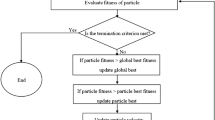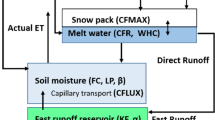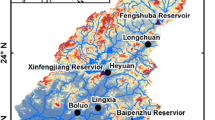Abstract
Management and analyses of water resources is of paramount importance in the implementation of water related sustainable development goals. Hydraulic models are key in flood forecasting and simulation applied to a river flood analysis and risk prediction and an accurate estimation of the roughness is one of the main factors in predicting the discharge in a stream. In practical implementation roughness can be represented by the prediction of the well known Manning’s coefficient necessary for discharge calculation. In this paper we design an objective function that measures the quality of a given configuration of the Manning’s coefficient. Such an objective function is optimised through several evolutionary approaches, namely: (1+1)-ES, CMA-ES, Differential Evolution, Particle Swarm Optimization and Bayesian Optimization. As case of study, a river in the central Italy was considered. The results indicate that the model, consistent with the classical techniques adopted in the hydraulic engineering field, is applicable to natural rivers and is able to provide an estimation of the roughness coefficients with a satisfactory accuracy. A comparison of the performances of the five evolutionary algorithms is also proposed.
Access this chapter
Tax calculation will be finalised at checkout
Purchases are for personal use only
Similar content being viewed by others
Notes
- 1.
References
HEC-RAS, User Manual, Davis Version 4.0
Atanov, G.A., Evseeva, E.G., Meselhe, E.A.: Estimation of roughness profile in trapezoidal open channels. J. Hydraulic Eng. 125(3), 309–312 (1999)
Baioletti, M., Milani, A., Santucci, V.: Variable neighborhood algebraic differential evolution: An application to the linear ordering problem with cumulative costs. Inf. Sci. 507, 37–52 (2020)
Becker, L., Yeh, W.W.G.: Identification of parameters in unsteady open channel flows. Water Resour. Res. 8(4), 956–965 (1972)
Becker, L., Yeh, W.W.G.: Identification of multiple reach channel parameters. Water Resour. Res. 9(2), 326–335 (1973)
Beyer, H.G., Schwefel, H.P.: Evolution strategies - A comprehensive introduction. Nat. Comput. 1(1), 3–52 (2002)
Brabazon, A., O’Neill, M., McGarraghy, S.: Natural Computing Algorithms, 1st edn. Springer, Cham (2015)
Di Francesco, S., Zarghami, A., Biscarini, C., Manciola, P.: Wall roughness effect in the lattice Boltzmann method. In: AIP Conference Proceedings, vol. 1558, pp. 1677–1680. American Institute of Physics (2013)
Di Francesco, S., Biscarini, C., Manciola, P.: Numerical simulation of water free-surface flows through a front-tracking lattice Boltzmann approach. J. Hydroinformatics 17(1), 1–6 (2015)
Di Francesco, S., Biscarini, C., Manciola, P.: Characterization of a flood event through a sediment analysis: the Tescio river case study. Water 8(7), 308 (2016)
Drake, J., Bradford, A., Joy, D.: Application of HEC-RAS 4.0 temperature model to estimate groundwater contributions to Swan Creek, Ontario, Canada. J. Hydrol. 389(3), 390–398 (2010)
Frazier, P.I.: A tutorial on bayesian optimization. Preprint arXiv:1807.02811 (2018)
Gray, D.N., Hotchkiss, J., LaForge, S., Shalit, A., Weinberg, T.: Modern languages and Microsoft’s component object model. Commun. ACM 41(5), 55–65 (1998)
Hansen, N., Ostermeier, A.: Completely derandomized self-adaptation in evolution strategies. Evol. Comput. 9(2), 159–195 (2001)
Hollander, M., Wolfe, D.A., Chicken, E.: Nonparametric statistical methods, vol. 751. Wiley (2013)
Horritt, M., Bates, P.: Evaluation of 1D and 2D numerical models for predicting river flood inundation. J. Hydrol. 268(1), 87–99 (2002)
Kachiashvili, K.: Software realization problems of mathematical models of pollutants transport in rivers. Adv. Eng. Softw. 40(10), 1063–1073 (2009)
Kennedy, J., Eberhart, R.: Particle swarm optimization. In: Proceedings of IEEE International Conference on Neural Networks, vol. 4, pp. 1942–1948 (1995)
Larsen, R.B., Jouffroy, J., Lassen, B.: On the premature convergence of particle swarm optimization. In: Proceedings of 2016 Eur. Control Conference, pp. 1922–1927 (2016)
Perry, B.: Open-channel hydraulics. Science 131(3408), 1215–1215 (1960)
Pinar, E., et al.: Artificial neural network approaches for prediction of backwater through arched bridge constrictions. Adv. Eng. Softw 41(4), 627–635 (2010)
Rapin, J., Teytaud, O.: Nevergrad - A gradient-free optimization platform (2018). https://GitHub.com/FacebookResearch/Nevergrad
Rapin, J., Bennet, P., Centeno, E., Haziza, D., Moreau, A., Teytaud, O.: Open source evolutionary structured optimization. In: Proceedings of the 2020 Genetic and Evolutionary Computation Conference Companion, pp. 1599–1607 (2020)
Rodriguez, L.B., Cello, P.A., Vionnet, C.A., Goodrich, D.: Fully conservative coupling of HEC-RAS with MODFLOW to simulate stream-aquifer interactions in a drainage basin. J. Hydrol. 353(1), 129–142 (2008)
Santucci, V., Baioletti, M., Di Bari, G., Milani, A.: A binary algebraic differential evolution for the MultiDimensional two-way number partitioning problem. In: Liefooghe, A., Paquete, L. (eds.) EvoCOP 2019. LNCS, vol. 11452, pp. 17–32. Springer, Cham (2019). https://doi.org/10.1007/978-3-030-16711-0_2
Santucci, V., Milani, A., Caraffini, F.: An optimisation-driven prediction method for automated diagnosis and prognosis. Mathematics 7(11), 1051 (2019)
Shen, D., Jia, Y., Altinakar, M., Bingner, R.L.: GIS-based channel flow and sediment transport simulation using CCHE1D coupled with AnnAGNPS. J. Hydraul. Res. 54(5), 567–574 (2016)
Storn, R., Price, K.: Differential evolution - a simple and efficient heuristic for global optimization over continuous spaces. J. Global Optim. 11(4), 341–359 (1997)
Violante, C., Biscarini, C., Esposito, E., Molisso, F., Porfido, S., Sacchi, M., et al.: The consequences of hydrological events on steep coastal watersheds: the Costa d’Amalfi, eastern Tyrrhenian Sea. IAHS Publ. 327, 102 (2009)
Zischg, A.P., Mosimann, M., Bernet, D.B., Röthlisberger, V.: Validation of 2D flood models with insurance claims. J. Hydrol. 557, 350–361 (2018)
Acknowledgement
This work was partially supported by the following research grants: (i) Università per Stranieri di Perugia – Progetto di ricerca Artificial Intelligence for Education, Social and Human Sciences; (ii) Università per Stranieri di Perugia – Finanziamento per Progetti di Ricerca di Ateneo—PRA 2020; (iii) PRIN project PHRAME: Phraseological Complexity Measures in learner Italian.
Author information
Authors and Affiliations
Corresponding author
Editor information
Editors and Affiliations
Rights and permissions
Copyright information
© 2021 Springer Nature Switzerland AG
About this paper
Cite this paper
Agresta, A., Baioletti, M., Biscarini, C., Milani, A., Santucci, V. (2021). Evolutionary Algorithms for Roughness Coefficient Estimation in River Flow Analyses. In: Castillo, P.A., Jiménez Laredo, J.L. (eds) Applications of Evolutionary Computation. EvoApplications 2021. Lecture Notes in Computer Science(), vol 12694. Springer, Cham. https://doi.org/10.1007/978-3-030-72699-7_50
Download citation
DOI: https://doi.org/10.1007/978-3-030-72699-7_50
Published:
Publisher Name: Springer, Cham
Print ISBN: 978-3-030-72698-0
Online ISBN: 978-3-030-72699-7
eBook Packages: Computer ScienceComputer Science (R0)




